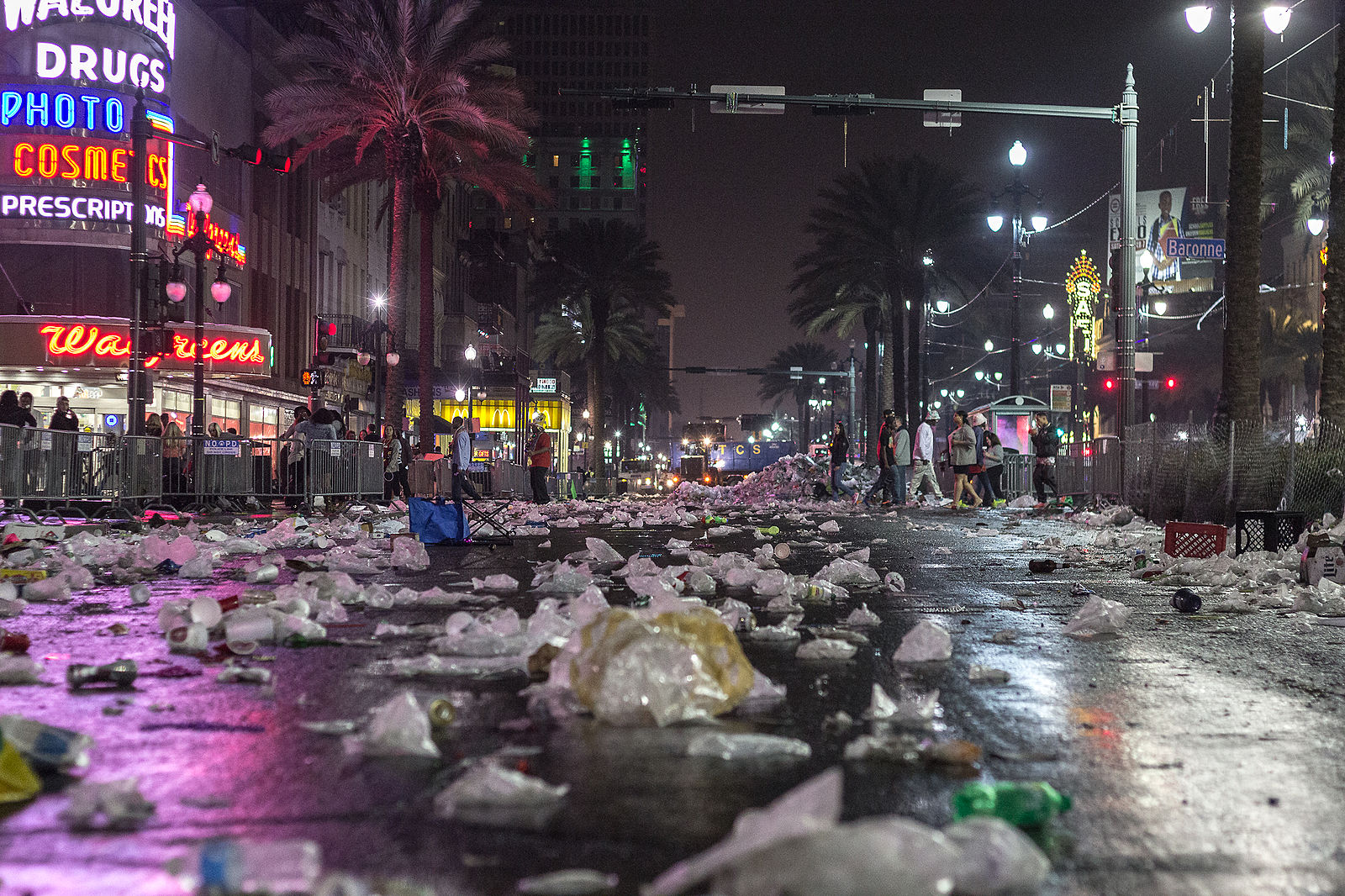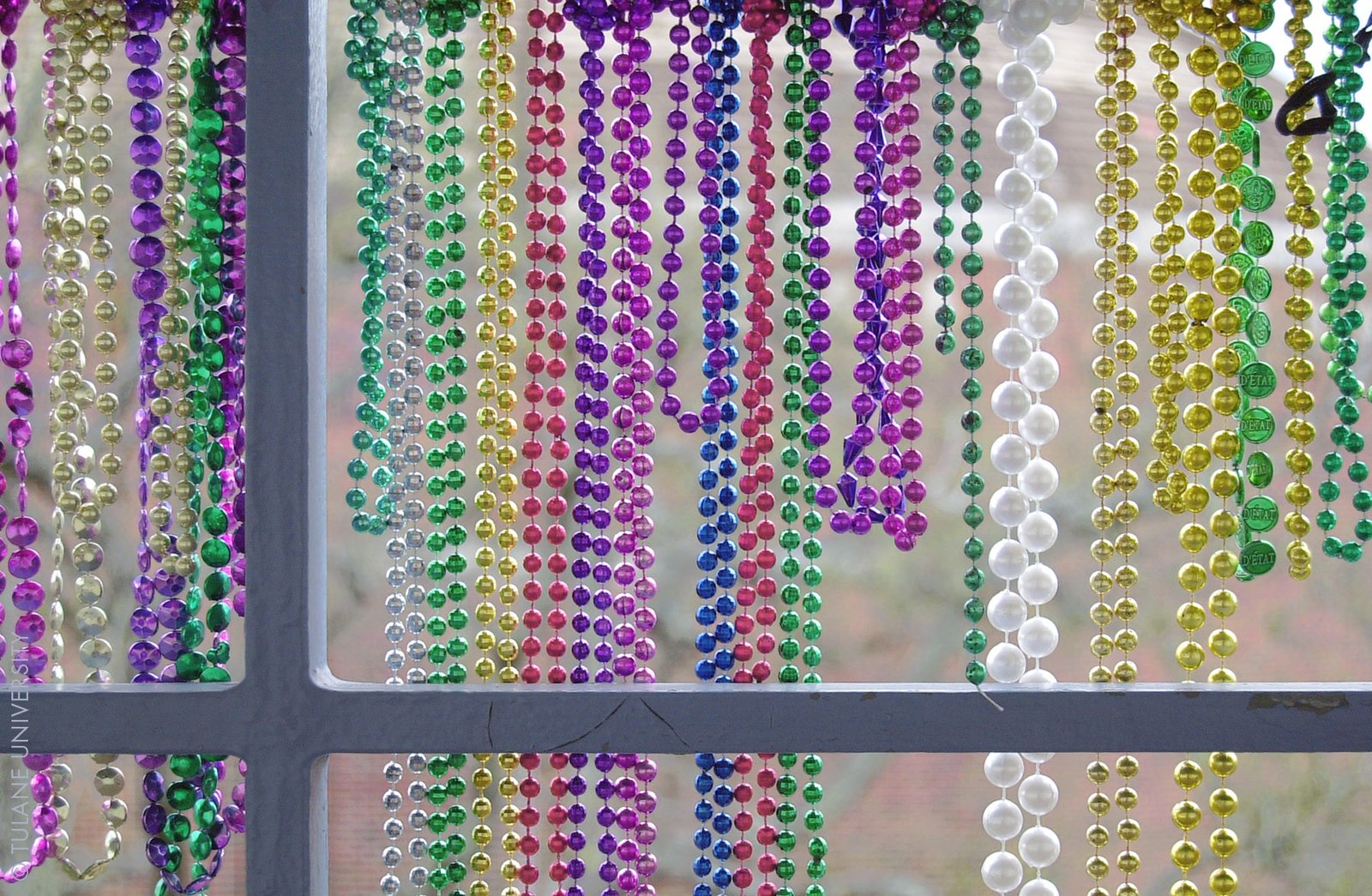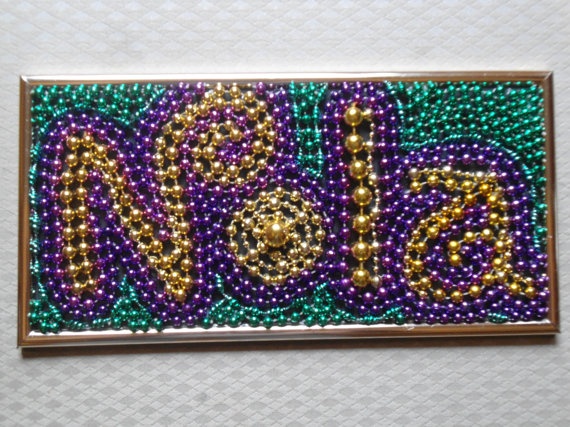Part I: The Issue
It’s no secret that Mardi Gras isn’t exactly the most environmentally friendly weeks-long celebration. In fact, some say it “could be considered one of the region’s top petrochemical polluters” (Welch). If you weren’t aware, petrochemicals include plastics, soaps, detergents, drugs, fertilizers, explosives, paints, synthetic fibers and rubbers, and a plethora of other petroleum or natural gas-based substances that are essentially eco-killers. This consideration isn’t entirely baseless, either. On average, sanitation crews clean up about 900 tons of waste each year, and in 2018, that number was bumped up to 1,200 tons. Plastic cups, beads, hats, doubloons, toys, and colorful beads create up to 1.2 million pounds of waste within only 14 days of the year. Within a 5-block stretch of St. Charles, 46 tons of Mardi Gras beads (about 93,000 beads) were found in the New Orleans drainage system in 2017.

Trash from Mardi Gras on Canal Street, New Orleans (Wikimedia Commons)
Not only are the disposal of Mardi Gras throws incredibly wasteful considering that plastic, which a majority of the time the throws are made of, does not ever decompose, but they also pose a threat to the health and safety of the community and the environment because of lead that can be detected on the surface of some beads. Not only does lead exist on the beads themselves, but it accumulates on the ground along the curbside of the parade route. The asphalt and soil following the up to 5-mile trek that parade floats take can be littered with the lead contamination that has accumulated for years and years of Mardi Gras celebrations.
In recent years, though, New Orleans residents have taken Mardi Gras waste’s environmental impact more seriously. Sustainable companies such as Grounds Krewe, Epiphany Throws, and Atlas Beads have offered alternative options for beads, necklaces, jewelry, and other throws for Krewe members and parade-goers. In 2020, Grounds Krewe sold about 8,000 of their food throws to different floats rolling along parade routes. LSU has also taken part in the initiative to create a greener carnival celebration by introducing a biodegradable bead option produced from microscopic algae that are grown, harvested, and ground into a powder that creates a substance similar to plastic in which beads can be made. There is an issue, however, with these sustainability ventures that Atlas, LSU, and Grounds Krewe have taken on: the price tag.
The “Belize Co-op palm tree seed bead necklace,” produced and distributed by Grounds Krewe, sells for $51. For one necklace. The “demeter acai seed necklace” by Epiphany Throws sells a 6-pack for $30, and the “circle recycled t-shirt headband,” also in a six-pack, goes for a whopping $24. Atlas, though less expensive, doesn’t do much better in the price department. Their “standard necklace,” single, goes for $10, and if you’re really feeling fancy, you can get the “big beads” necklace for $16. Even the algae-bead development at LSU isn’t financially sustainable. As of now, the beads are projected to go for $13 per necklace. Though researchers are hoping to cut the price down to $1 per strand, this would still be about 20 times the current price of beads, which typically goes for about 5 cents per strand.

Mardi Gras beads. (Photo: Wikimedia Commons)
For those in the middle to the upper class with a stable income, purchasing environmentally friendly beads, throws, and other Mardi Gras goodies should be a no-brainer. However, the unfortunate truth is that these beads are not accessible to a large portion of New Orleans residents. According to Total Community Action Incorporated, around 80-83,000 New Orleans live below the poverty line. About 21% of families live at or below the poverty line in the city. To make things worse, 38% of New Orleans households are asset poor, including 28% who earn between $45,655 and $70,014. The national average of people in poverty is 14%, making New Orleans a standout region for low-income lifestyles. Just as the pollution caused by Mardi Gras is no secret, neither is the volume of extremely poor citizens living in the New Orleans community.
With these statistics in mind, it’s borderline offensive that companies are attempting to provide sustainable options for such a ridiculously high price, considering the amount of people that experience poverty in New Orleans. These sustainable companies mentioned above are clearly excluding the poor communities in New Orleans from purchasing their product. Though their efforts are good-natured, they are bound to be ineffective when you can buy a 72-pack of beads on Amazon for a mere $17.
The amount of waste produced during Mardi Gras is an essential problem that needs immediate fixing if we are striving to protect the environment and community around us. However, if there aren’t cost-effective options to facilitate an environmentally sustainable parade, especially in a community ridden with high poverty rates and low-income living, there will be no hope for a greener future.
Part II: The Solution
Though a majority of the environmentally friendly options for Mardi Gras are inaccessible to a large percentage of the New Orleans population, some groups are beginning to implement programs that make sustainability possible for low-income areas. Arc of Greater New Orleans is an online and in-person organization that recycles beads and other festive Mardi Gras items. They encourage bead donations in the form of bead drives or drops off at collection sites around the city and provide opportunities for New Orleans citizens to volunteer and buy beads in-store and online. However, ArcGNO is one of the only large organizations that encourages Mardi Gras-goers to recycle and reuse their beads. With a population of 390,845 people in New Orleans and 4.649 million in Louisiana at large, it would be nearly impossible for this non-profit to reach the wide span of individuals that attend Mardi Gras each year.
However, I believe that ArcGNO has the right idea when it comes to affordable Mardi Gras sustainability. The fact of the matter is that the plastic that has already been created is not going away anytime soon. Although bead options made out of sustainable materials are up and coming, it will be years before affordable options will be available for people of all socio-economic classes. In the meantime, recycling and reusing the existing beads and throws is one of the best ways to combat this issue. Luckily, a similar waste-free alternative option already exists in another realm: clothing. The process of thrifting has been an extremely successful, sustainable option that has appealed to a wide variety of people over the past century or so. From consignment stores ridden with vintage Gucci and Prada to the hidden gems often found at your local Goodwill, thrifting has redefined what it means to reuse.
Since the 1300s, clothing has been traded between communities. In fact, Dennita Sewell, a professor of practice at the Herberger Institute for Design and Arts, describes how “secondhand trade is one of the oldest forms of clothing for the common man” (Sewell). For low-income communities especially, clothing trade was convenient and ideal. In the 19th century during the industrial revolution, the mass production of clothing instigated a culture that began to view clothing as disposable. Rather than simply stitching and mending old clothes that had been worn and torn, many people opted to buy a new wardrobe altogether. This increase in availability led to the development of a harmful stigma attached to used and worn clothes. At the time, “Used clothes were available from pushcarts predominantly started by Jewish immigrants who were often met with anti-semitism” (Waxman). Not only were used clothes a sign of low income but they were also associated with a group often discriminated against in the 19th century. A satirical story was even run by the Saturday Evening Post in 1884 about a “girl who got smallpox from a dress she bought from a Jewish-owned resale shop” (Waxman). Not only was reusing clothes unpopular, but it was also entirely embarrassing.
However, Christian Ministries began getting involved in the late 19th century as they saw an opportunity bursting with potential. Secondhand clothing stores such as Goodwill and the Salvation Army launched their initiatives to support the poor communities surrounding them and give back to outreach programs in the process. Not only did these non-profits provide clothing necessities, but also social-service operations along with these retail goods. In the 1920s, thrift stores developed into department stores, and as the practice gained more popularity, the terminology surrounding secondhand clothing changed. Now, rather than “junk shops,” secondhand stores were considered “thrift stores.” Rather than thrifted clothing being seen as dirty and useless, it “reflected a marketing appeal that allowed middle-class housewives to “feel virtuous about buying something new because they can give something back” (Waxman).
The ability for secondhand clothing to go from trashy to trendy, from virulent to vintage, and from disgusting to desired is precisely why I think this could be an effective way for sustainability to be implemented into Mardi Gras celebrations. If you think about it, the idea of secondhand beads actually has a leg up as opposed to secondhand clothing, considering that the idea of reusing beads is not currently frowned upon in today’s society. In fact, many people, including myself, opt to keep their beads and re-wear them during festive New Orleans events. If recycling beads was seen as sustainable and trendy, then bead collection stores could easily gain popularity, similar to how the clothing industry has. By encouraging a cultural movement in which bead recycling is simply the norm in different socio-economic communities, a sustainable future for Mardi Gras celebrations does not seem far out of reach.
Part III: Implementation
Implementing a system in the New Orleans area similar to secondhand thrift stores is certainly one of the most effective ways to reduce waste during Mardi Gras. As I mentioned earlier, the plastic produced and distributed for Mardi Gras purposes is not going away anytime soon, so rather than creating new, expensive products that are environmentally friendly, a more effective way to combat this issue is to reuse secondhand beads for the annual holiday. Not only is this a sustainable way to celebrate carnival, but it also, similar to secondhand thrifting, appeals to lower-income areas of New Orleans that deserve to have access to sustainable options.
Luckily, a NOLA-based organization similar to this already exists! Arc of the Greater New Orleans Area (ArcGNO) is a “67-year-old non-profit organization dedicated to advancing the independence and well-being of people with intellectual and developmental disabilities such as Down syndrome, cerebral palsy, and autism”. Along with the incredible work they do for disabled communities, ArcGNO has, in order to raise money, provided useful services that encourage sustainability during Mardi Gras. All beads are recycled from past parades, and the prices are much more reasonable for the low-income population of New Orleans. For instance, 60 dozen of the 45” beads are only $40. These Prices are easily comparable to that of Amazon, and purchasing from ArcGNO is even more convenient considering that they have in-store and online options.

Recycled Mardi Grad Bead Art
However, the only problem that ArcGNO runs into is its lack of reach. Though the organization is quite literally doing everything right when it comes to secondhand sustainability, ArcGNO only has nine collection sites among five different parishes and four in-person stores. For an organization like ArcGNO to make a difference to the point that Mardi Gras changes forever, the number one route that will facilitate this success is expansion.
Expansion is obviously important for all areas of New Orleans, the entirety of Louisiana, and parts of Mississippi and Alabama, but it’s most important that expansion is focused in low-income areas. As of now, a majority of sustainable options for Mardi Gras are not affordable for the dense population of impoverished New Orleans. Someone with a low income would be much more inclined to buy a pack of 72 beads on Amazon for $17 rather than a single necklace for $51. There needs to be an immense push to expand organizations such as ArcGNO and other secondhand Mardi Gras stores in areas that don’t have accessibility to other kinds of sustainable options.
Secondhand Mardi Gras stores should be not just accessible, though. To truly make a difference in the community, they need to become the norm. In the end, the goal is to completely eradicate any businesses that actively want to sell new plastic products. If buying beads and other Mardi Gras trinkets secondhand became something trendy that everyone was doing, I think this “bead thrifting” business model could be very successful. Mardi Gras has so many incredible traditions and has helped define New Orleans for centuries. In order to preserve not only these traditions but our city, we must implement sustainable, affordable options in low-income communities in order to become a catalyst for positive, earth-loving change.
This piece was edited by Jiayi Xu as part of Professor Kelley Crawford’s Digital Civic Engagement course at Tulane University.
 NOLAbeings
Multimedia artist Claire Bangser created NOLAbeings as a portrait-based story project that marries...
NOLAbeings
Multimedia artist Claire Bangser created NOLAbeings as a portrait-based story project that marries...
 Data corner: Adobe Suite (create a PDF, social media graphic, presentation, edit a photo and video
Data corner is where you go to work with analytics and top tech skills. It takes on everything from PERL and SQL to Canva and Sprout Social.
Data corner: Adobe Suite (create a PDF, social media graphic, presentation, edit a photo and video
Data corner is where you go to work with analytics and top tech skills. It takes on everything from PERL and SQL to Canva and Sprout Social.
